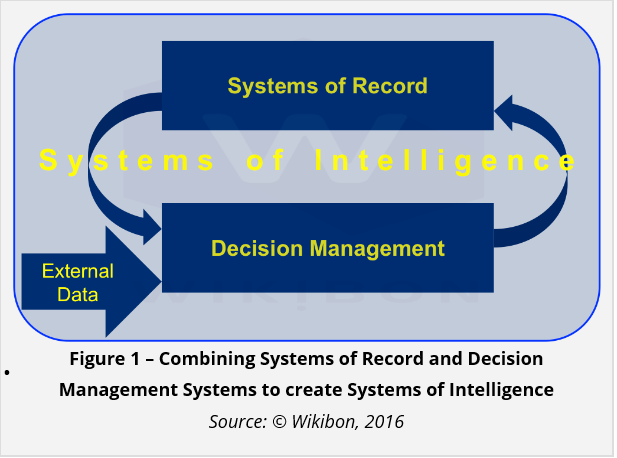 NEWS
NEWS
 NEWS
NEWS
 NEWS
NEWS
Enterprises can realize transformativel business advantages by streamlining their existing systems of record and adding inline analytics, including predictive analytics and modern decision management systems. This creates a coherent and agile new operating model that Wikibon calls “systems of intelligence.” The resulting information, writes Wikibon CTO and Co-Founder David Floyer, must be made available both to management and directly to machines for millisecond response to changing business conditions.
While some companies have succeeded in migrating their systems of record to a new platform, the process can create large amounts of extra expense and eat up time. The better strategy, says Floyer, is to work with systems of record on their existing platforms, which can be anything from IBM System z mainframes to large Unix and Linux systems, to Microsoft Windows servers. These core systems should be upgraded to create a true private cloud to make them competitive in cost to public cloud platforms.
Whichever strategy the enterprise follows, Floyer emphasizes that the intelligence derived from these systems must be in near-real-time. And they must be available and used by management at all levels of the organization. A mid-2015 Wikibon survey showed that many companies were realizing only 50 cents of ROI for every dollar invested in their initial big data projects. Wikibon believes that this disappointing rate of return is in large part the product of restricting the results to a few senior managers. Making a few people even smarter does not create a data-driven organization.
“The harsh truth is that reports and sophisticated charts are used more as weapons to protect and advance than a shared resource for the advancement of the company as a whole,” he writes. “By focusing on each line of business and making incremental change which automates the business, the changes are permanent, can be improved iteratively and are owned by the line of business.”
Floyer also disagrees with Gartner, Inc.’s two-mode IT model, in which systems of record basically continue as they are in Mode-1 IT, while the new big data systems and analysis become Mode-2. This creates a weak link in the data chain and makes real-time analysis that combines traditional business data with new data streams impossible.
The full report includes two business models of implementation for systems of intelligence. The first proposed that, if implemented correctly, a 20,000-person organization can either eliminate or reassign 15 center of its employees without sacrificing outputs. If reassigned, those employees can then generate an incremental $1 billion annually within five years. Resulting revenue per employee for the company will increase by 35 percent over five years.
The full report also discusses central improvements that are needed to the infrastructure, including conversion to all-flash storage. The second business case looks in depth at the costs and returns for upgrading and creating a system of intelligence on top of a large transactional system running on an IBM System z mainframe. One finding is that “there is no free lunch.” In Wikibon’s models, a company with a $200M IT budget must increase IT spending by 12.5 percent annually, from 4 percent to 4.5 percent of revenue, to achieve the desired results.
“By incentivizing all levels of management and professionals to adopt this approach, organizations will be able achieve large and sustainable returns on investment,” he concludes. “All other strategies, especially those requiring conversion of systems of record to another platform or another package, will almost certainly add years to the project and add enormous business risk.”
Support our open free content by sharing and engaging with our content and community.
Where Technology Leaders Connect, Share Intelligence & Create Opportunities
SiliconANGLE Media is a recognized leader in digital media innovation serving innovative audiences and brands, bringing together cutting-edge technology, influential content, strategic insights and real-time audience engagement. As the parent company of SiliconANGLE, theCUBE Network, theCUBE Research, CUBE365, theCUBE AI and theCUBE SuperStudios — such as those established in Silicon Valley and the New York Stock Exchange (NYSE) — SiliconANGLE Media operates at the intersection of media, technology, and AI. .
Founded by tech visionaries John Furrier and Dave Vellante, SiliconANGLE Media has built a powerful ecosystem of industry-leading digital media brands, with a reach of 15+ million elite tech professionals. The company’s new, proprietary theCUBE AI Video cloud is breaking ground in audience interaction, leveraging theCUBEai.com neural network to help technology companies make data-driven decisions and stay at the forefront of industry conversations.